List of B-29 Superfortress operators
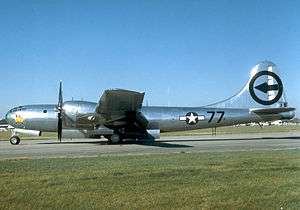
This is a list of B-29 Superfortress units consisting of nations, their air forces, and the unit assignments that used the B-29 during World War II, Korean War, and post war periods, including variants and other historical information
Delivery of the first YB-29 test aircraft (YB-29-BW 41-36954) to the USAAF was made in June 1943, being delivered to the 58th Bombardment Wing, 40th Bombardment Group.[2][3] The first production B-29s began to roll off the production lines at Boeing-Wichita in September 1943, also going to the 58th BW.
The last B-29 was delivered by Boeing-Wichita (B-29-100-BW, 45-21872) in September 1945.[4] 21872 was converted to a WB-29; being destroyed in a crash on 25 September 1953 near Eielson AFB, Alaska, when assigned to the 58th Strategic Reconnaissance Squadron (Medium), Weather.[5][6]
United States
United States Army Air Forces
Combat Groups
Army Air Forces B-29 groups and squadrons assigned to operations as part of the Pacific War against the Japanese Empire, 1944–1945. Includes units assigned to the XX Bomber Command in the China-Burma-India Theater (April 1944-February 1945), and to XXI Bomber Command in the Pacific Theater of Operations (PTO) (March–August 1945). Also includes groups and squadrons deployed to Okinawa assigned to Eighth Air Force, in July/August 1945 but did not engage in combat operations.
|
|
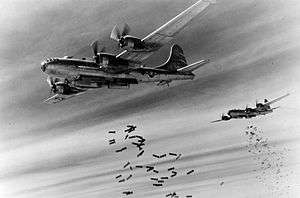
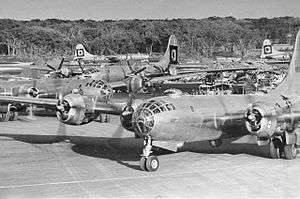
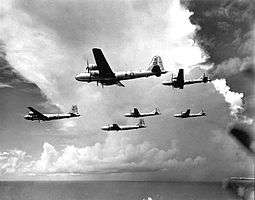
Combat Reconnaissance Squadrons
- 1st Photographic Reconnaissance Squadron, (F-13A, 1944–1947)
- 3d Photographic Reconnaissance Squadron, (F-13A, 1944–1947)
Non-Combat Groups
Army Air Forces groups which were assigned to Second Air Force for conversion B-29 training during the summer of 1945. These groups were returned to the United States from the European Theater of Operations (ETO) after the German Capitulation in May 1945, and were programmed to redeploy to the Pacific Theater of Operations (PTO) after their training was completed. However, the Japanese Capitulation and the end of combat in the PTO led to their inactivation after August 1945.
|
|
|
|
.* Note: The 472d Bombardment Group was a Second Air Force Operational Training Unit for initial B-29 crew training established in 1943; the 5th Bombardment Group was redesignated and reequipped as a B-29 unit by Far East Air Forces and assigned to Thirteenth Air Force in the Philippines in 1946 from aircraft and equipment of former XXI Bomber Command units which had inactivated. The 5th BG was a prewar bomb group assigned to Hawaii at the time of the Pearl Harbor Attack; its B-17s largely destroyed on the ground at Hickam Field. The unit was reformed into a B-24 Liberator heavy bomb group after the attack and was assigned to Thirteenth AF during the war; the 32d Composite Wing flew RB-29s for Far East Air Forces in the late 1940s, primarily as photo-mapping aircraft over China, Formosa, Indochina and Korea.
Strategic Air Command (Groups)
Army Air Forces B-29 bomb groups assigned to Strategic Air Command (SAC) after the command's establishment in March 1946. Includes groups that were returned to the United States from the European Theater and were programmed to redeploy to the Pacific Theater of Operations (PTO) after their B-29 conversion training was completed. These units were retained on active service after the Japanese Capitulation in August 1945 and were assigned to Continental Air Forces (CAF). In March 1946 were transferred to SAC upon redesignation of CAF to SAC.
Many of these units and squadrons were under-manned and under-equipped due to the rapid demobilization of the armed forces in this period. In addition, frequent inactivations and activations were made, with older, prewar units being reactivated in place of younger, wartime units. Up until the end of the Korean War, SAC used tail markings that consisted of a combination of geometric shapes and letters. The shape would indicate the Numbered Air Force, with a triangle representing the Eighth Air Force; a circle for Fifteenth Air Force and a square for Second Air Force. This system was phased out in 1953.
SAC Reconnaissance Squadrons
|
|
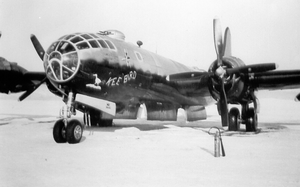
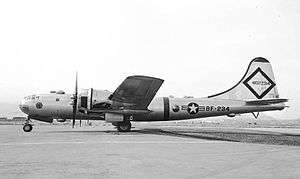

United States Air Force
Strategic Air Command (Wings)
The B-29 was the mainstay of Strategic Air Command after World War II until the Korean War. B-29 "Very Heavy" bomber units were redesignated "Medium" with the introduction of the B-36 Peacemaker into the inventory in 1948, with some units transitioning to the B-36/RB-36 beginning in 1949. The B-50 Superfortress, an advanced version of the B-29 was also introduced in 1949.
SAC deployed non nuclear-capable B-29 groups to Far East Air Forces in 1950 to conduct strategic bombardment missions over the skies of North Korea, however the aircraft was made obsolete by the development of Soviet jet-powered interceptors such as the MiG-15. The B-29 soldiered on for a more few years in the strategic bombardment role, but by 1955 was replaced by the B-47 Stratojet medium bomber.
In 1950, conversions of B-29s to KB-29P aerial tankers began to reach SAC squadrons. KB-29s were in service with SAC until being replaced by the KC-97 Stratofreighter (which was itself based on the B-29) by 1955.
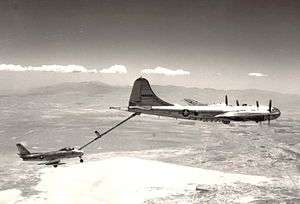
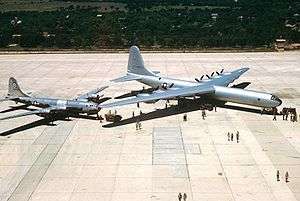
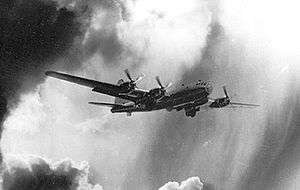
Tactical Air Command
After the Korean War and the phaseout of the B-29/KB-29 from SAC, KB-29s were acquired by Tactical Air Command to serve as dedicated aerial refueling tankers for Tactical Fighter aircraft to give TAC a worldwide deployment capability separate from SAC. However, it was found that the KB-29 was totally unsuitable for the refuelling of jet fighters because they were too slow. The KB-29s were replaced beginning in 1956 with faster KB-50s.
- 420th Air Refueling Squadron, (KB-29M, 1954–1955) (USAFE)
- 421st Air Refueling Squadron, (KB-29M, 1954–1955) (PACAF)
- 427th Air Refueling Squadron, (KB-29M, 1956–1959)
- 429th Air Refueling Squadron, (KB-29M, 1954–1958)
- 431st Air Refueling Squadron, (KB-29M, 1957)
- 622d Air Refueling Squadron, (KB-29M, 1955–1957)
Air Resupply And Communications Service
During the Cold War, the Military Air Transport Service the controlling command for Air Commando units which performed special operations during the 1950s, including during the Korean War. As part of the equipment used by the Air Resupply And Communications Service (ARCS) were B-29s modified for special operations missions.
- 580th Air Resupply and Communications Wing, (B-29, 1951–1956)
- 581st Air Resupply and Communications Wing, (B-29, 1951–1956)
- 582nd Air Resupply and Communications Wing, (B-29, 1952–1956)
Air Weather Service
Air Weather Service (part of Military Air Transport Service) received their first B-29s in various versions (B-29, RB-29, TB-29, WB-29) in 1946 AWS initially used B-29s in support of the 1946 Operation Crossroads atomic bomb tests at Bikini Atoll.
Weather reconnaissance duties required special variant of the B-29. Armament and related equipment was removed and in place of upper forward turret astrodome was installed. Additional radio and specialized meteorological equipment was installed and such refitted aircraft was redesignated WB-29.[7] While the B-29's "public" mission was that of weather reconnaissance, the "covert" mission, that of atmospheric sampling for radiation debris, was perhaps the more critical task.
WB-29s soldiered on through the mid-1950s, providing critical data on tropical storms, nuclear tests, and many other routine but important reconnaissance tasks. But the airplanes were weary, and by 1956 were replaced by a modification of seventy-eight B-50Ds to WB-50 configuration.
|
|
NOTE: *Under operational control of Far East Air Forces flying combat weather reconnaissance missions over North Korea during the Korean War
Weapons Systems Development/Testing

- Air Technical Service Command/Air Materiel Command/Air Research and Development Command, Muroc AAF/AFB (later Edwards AFB), California
- Air Proving Ground Command, Eglin AFB, Florida
B-29-96-BW serial number 45-21800 was used as the "mother" aircraft for launches of the Bell X-1 rocket-powered research aircraft at Edwards AFB. On October 14, 1947, Capt Charles E. "Chuck" Yeager was dropped in his X-1 from the B-29 and was credited as the first human to pilot an aircraft faster than the speed of sound.
Several B-29s were modified for various experimental purposes under the designation EB-29. Perhaps the best known of these was the EB-29 used as the carrier aircraft for the McDonnell XF-85 Goblin parasite fighter in 1948. The rear bomb bay was modified to carry a special cradle from which the XF-85 could be launched and retrieved in flight.
Other B-29s flown at Eglin/Muroc/Edwards AFB were XB-29E fire control test model; XG-29G (44-84043) which served as a flying test bed for J-35, J-47 and J-73 jet engines mounted in the bomb bay; the YB-29H used for special armament testing; YB-29J used for services testing of improved engine designs; QB-29 target drones. The CB-29K was an experimental transport version.
Air Defense Command
Beginning in 1954, the 4754th Radar Evaluation Squadron, Air Defense Command operated B-29s from various bases in the United States to provide ECM training and evaluation services to its radar site personnel. The B-29s contained an assortment of RADAR jamming devices to provide the required training of personnel.
- 4754th Radar Evaluation Electronics Counter-Countermeasure Flight, Hamilton AFB, California
- 4677th Radar Evaluation Electronics Counter-Countermeasure Flight, Hill AFB, Utah
- 4713th Radar Evaluation Flight, Griffiss AFB, New York
- 6023d Radar Evaluation Squadron, Naha AB, Okinawa (attached to Pacific Air Forces)
The last B-29 (a TB-29 radar evaluation aircraft, B-29-15-MO serial number 42-65234) was retired from the USAF inventory at 2010 hours on June 21, 1960, when Major Clarence C. Rarick of the 6023d Radar Evaluation Squadron landed at Naha Air Base, Okinawa, bringing the era of B-29 Superfortress military service to an end.
United States Navy


The United States Navy received four B-29s on April 14, 1947 and redesignated as P2B. Two of these aircraft were in standard configuration (P2B-1S), two another were equipped with test radar and additional fuel tank in bomb bay (P2B-2S).[8]
- P2B-1S BuNo 84028 (B-29-95-BW 45-21789)
- P2B-1S BuNo 84029 (B-29-95-BW 45-21787)
- P2B-2S BuNo 84030 (B-29-95-BW 45-21791)
- P2B-2S BuNo 84031 (B-29-90-BW 44-87766)
Naval B-29s were used as test beds and as mother ships in various programs. One P2B-1S was extensively modified to carry the Douglas D-558-II Skyrocket supersonic rocket-powered research aircraft. The first Skyrocket launch took place on September 8, 1950. The Skyrocket exceeded Mach 2 for the first time on November 20, 1953 (piloted by Scott Crossfield). The last Skyrocket flight took place in December 1956.
P2B-1S BuNo 84029 was later transferred to NACA for continuation of high-speed flight tests and was redesignated as NACA-137.[8] It was eventually sold to a civilian owner, a museum in Oakland, California. This was the only example of a flyable B-29 ever being sold to a civilian operator. This B-29 was flown on rare occasions under the civil registration N91329. After many years of inactivity, it was sold to the Kermit Weeks Aviation Museum of Miami, Florida. It was transported there disassembled in 1987. It was registered with the Weeks Museum as N29KW.
Allied nations
United Kingdom
The Royal Air Force urgently needed interim aircraft for their bomber squadrons briefly as a "stop gap" in the early 1950s, prior to the buildup of the RAF Canberra jet bomber force. This was considered an excellent arrangement from the RAF’s point of view as it provided experience of operating relatively modern equipment without diverting any of the development effort and investment from the Canberra and the V bombers.
A formal agreement with the USA was signed on January 27, 1950 and the USAF loaned the RAF seventy B-29 bombers which received the serials WF434-WF448, WF490-WF-514 and WF545-WF574. Later another 18 were delivered under serials WW342-WW356 and WZ966-WZ968.[9] The aircraft received the service name Boeing Washington B.1 (B.1 from "Bomber Mark 1") with RAF Bomber Command from 1950 as a longer-range nuclear-capable bomber, pending the introduction of the English Electric Canberra in quantity.
Most of the airframes were taken out of USAF storage and many were virtually new, having been delivered at the end of the Pacific War, although a small number came from operational units. The first 4 aircraft were delivered to the Washington Conversion Unit at RAF Marham on March 22, 1950. All B-29s for the RAF were ferried by the crews of the 307th Bombardment Wing USAF. The first unit converted to Washingtons was No. 115 Squadron RAF which flown from USA in June 1950.[9] Two RAF Washingtons took part in the Laurence Minot SAC bombing competition in 1951 alongside USAF B-29s.
Squadrons based at RAF Coningsby were converted to English Electric Canberra bombers in 1953. Squadrons from RAF Marham were converted a year later.[9] Most Washingtons were returned to the United States, being flown by RAF crews to Dover AFB; then subsequently to the aircraft storage facility at Davis-Monthan AFB. A small number of Washingtons remained in the United Kingdom, being used by 192 Sq. for Electronic Intelligence operations until 1958; later being used as ground target airframes for RAF combat aircraft.
- No. 15 Squadron RAF
- No. 44 Squadron RAF
- No. 57 Squadron RAF (moved from RAF Waddington in April 1952)[9]
- No. 149 Squadron RAF
- No. 192 Squadron RAF operated Washingtons between April 1952 and February 1958.[9]
Australia
Two ex-RAF Washingtons (WW354 and WW353) (former USAAF 44-61963; 44-62049) were turned over by the RAF to the Royal Australian Air Force Aeronautical Research and Development Unit in late 1952 and conducted trials for the United Kingdom's Ministry of Supply. They were assigned the RAAF serials A76-1 and A76-2. Both aircraft were retired in 1956 and sold for scrap in 1957.[10]
See also
- B-29 Superfortress
- B-29 Superfortress survivors
- B-29 Superfortress variants
- KB-29 Superfortress
- XB-39 Superfortress
- XB-44 Superfortress
- B-50 Superfortress
- C-97 Stratofreighter
- Boeing 377
- Tupolev Tu-4
References
Notes
- ↑ During World War II, this aircraft dropped the second Atomic Bomb on Nagasaki, Japan on 9 August 1945 while assigned to the 509th Composite Group, 393d Bombardment Squadron. The aircraft remained in service with the 509th Bombardment Group until 11 September 1946. It is now on permanent display at the National Museum of the United States Air Force, Wright-Patterson Air Force Base, Ohio.
- ↑ Baugher - Boeing YB-29 Superfortress
- ↑ USAFHRA - 58th Air Division
- ↑ USAF serial number search, B-29
- ↑ Air Force Weather Agency
- ↑ Eielson Lady of the lake
- ↑ Lloyd, B-29 Superfortress. Part 2
- 1 2 Lloyd, B-29 Superfortress. Part 2, p.68
- 1 2 3 4 5 Nowicki, B-29 Superfortress, p.16
- ↑ A76 Boeing Washington RAAF Museum. Accessed on 14 August 2007.
Bibliography
| Wikimedia Commons has media related to B-29 Superfortress. |
- Birdsall, Steve. B-29 Superfortress in Action (Aircraft in Action 31). Carrolton, Texas: Squadron/Signal Publications, Inc., 1977. ISBN 0-89747-030-3.
- Davis, Larry. B-29 Superfortress in Action (Aircraft in Action 165). Carrolton, Texas: Squadron/Signal Publications, 1997. ISBN 0-89747-370-1.
- Dorr, Robert F. B-29 Superfortress Units in World War Two (Combat Aircraft 33). Botley, Oxford, UK: Osprey Publishing, 2002. ISBN 1-84176-285-7.
- Fopp, Michael A. The Washington File. Tonbridge, kent, UK: Air-Britain (Historians) Ltd., 1983.
- Lloyd, Alwyn T. B-29 Superfortress. Part 1. Production Versions (Detail & Scale 10). Fallbrook, CA/London: Aero Publishers/Arms & Armour Press, Ltd., 1983. ISBN 0-8168-5019-4 (USA). ISBN 0-85368-527-4 (UK).
- Lloyd, Alwyn T. B-29 Superfortress. Part 2. Derivatives (Detail & Scale 25). Blue Ridge Summit, PA/London: TAB Books/Arms & Armour Press, Ltd., 1987. ISBN 0-8306-8035-7 (USA). ISBN 0-85368-839-7 (UK).
- Mayborn, Mitch. The Boeing B-29 Superfortress (aircraft in Profile 101). Windsor, Berkshire, UK: Profile Publications Ltd., 1971 (reprint).
- Nowicki, Jacek. B-29 Superfortress (Monografie Lotnicze 13) (in Polish). Gdańsk, Poland: AJ-Press, 1994. ISBN 83-86208-09-0.
- Pimlott, John. 'B-29 Superfortress. London: Bison Books Ltd., 1980. ISBN 0-89009-319-9.
- Rigmant, Vladimir. B-29, Tу-4 - стратегические близнецы - как это было (Авиация и космонавтика 17 (Крылья 4)). Moscow, Russia, 1996.